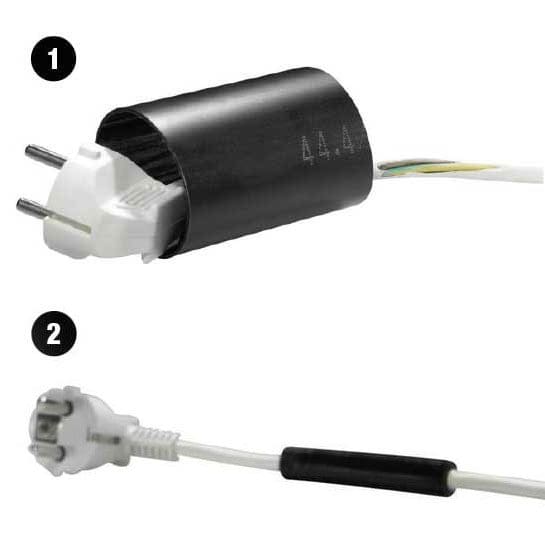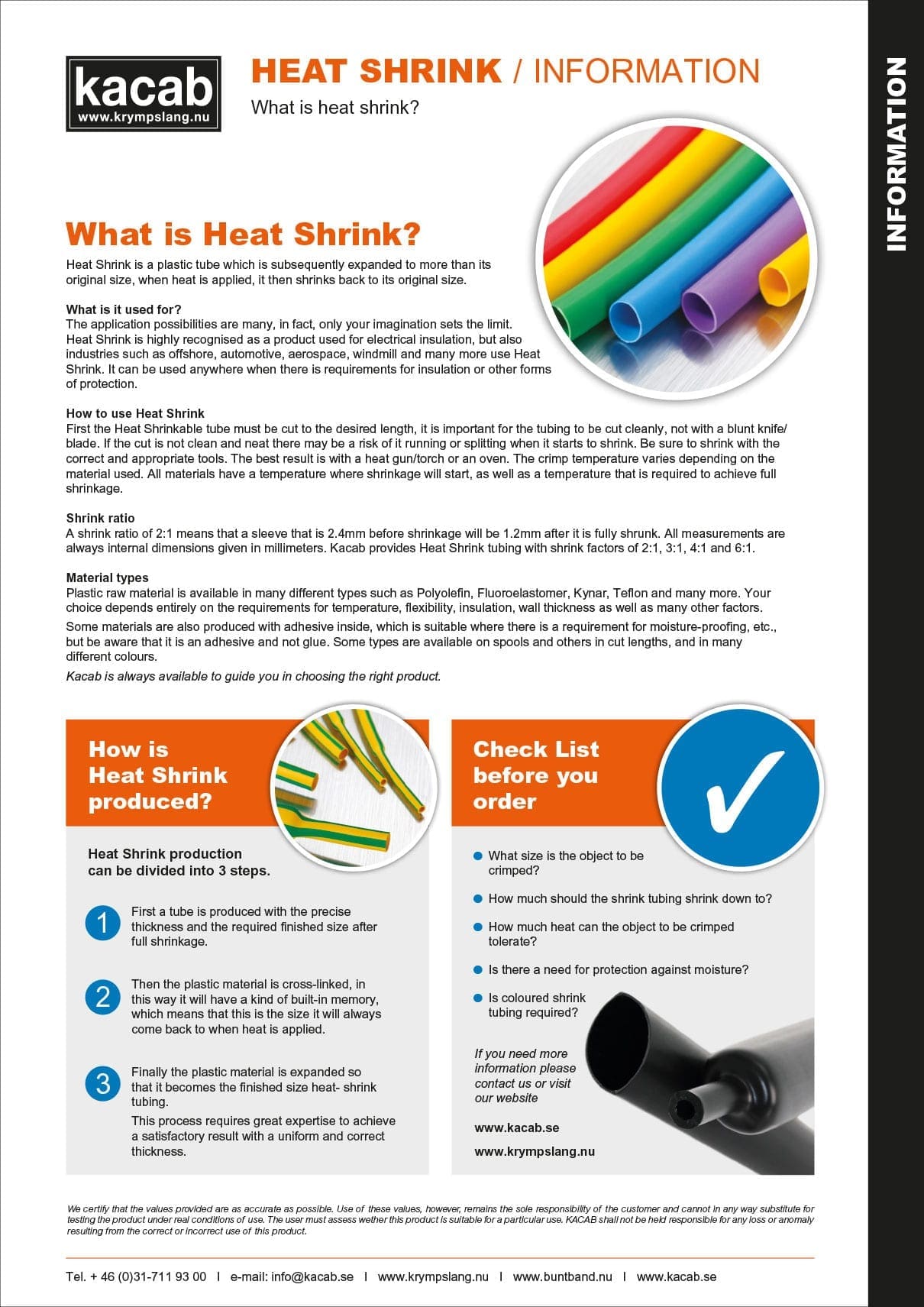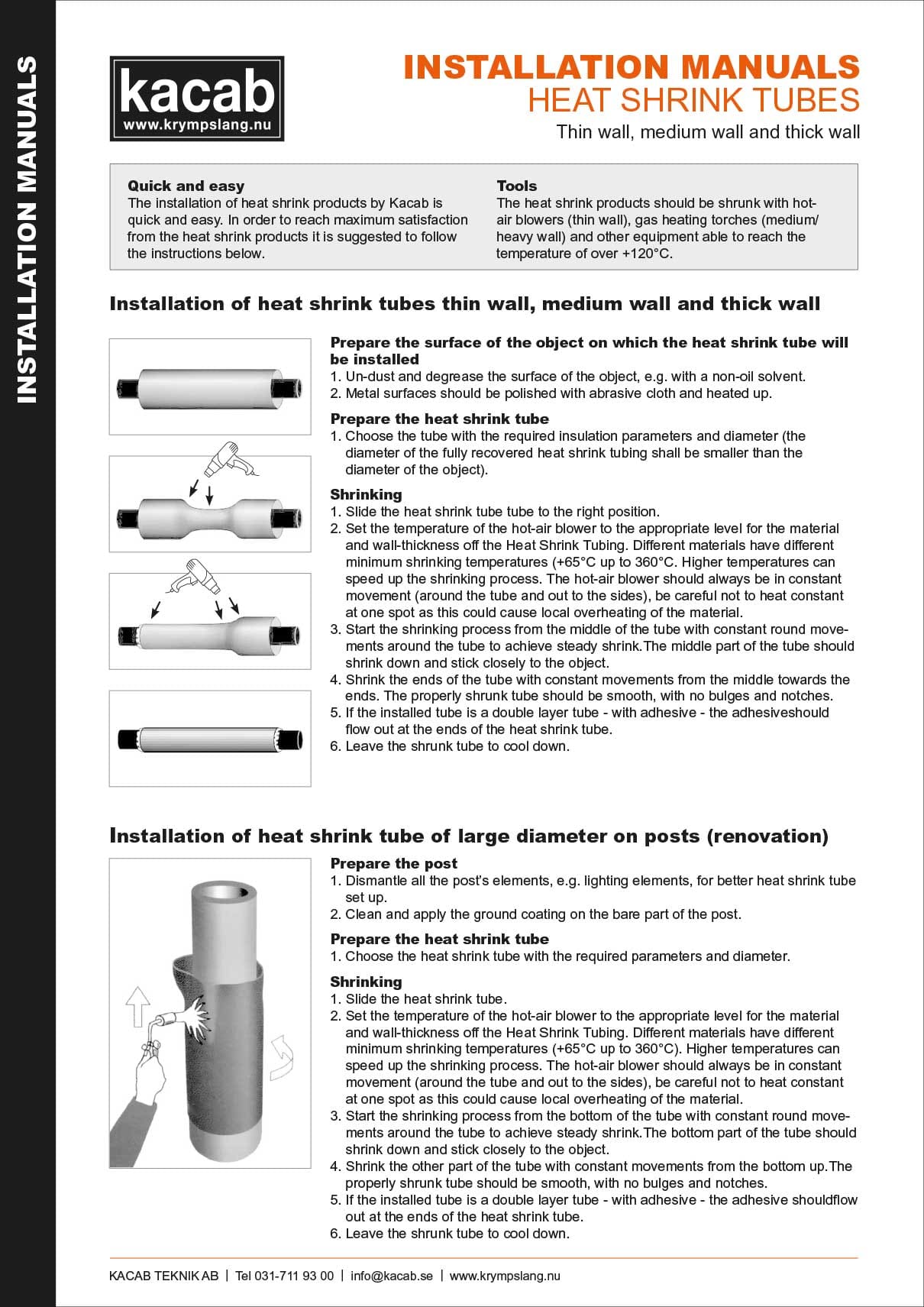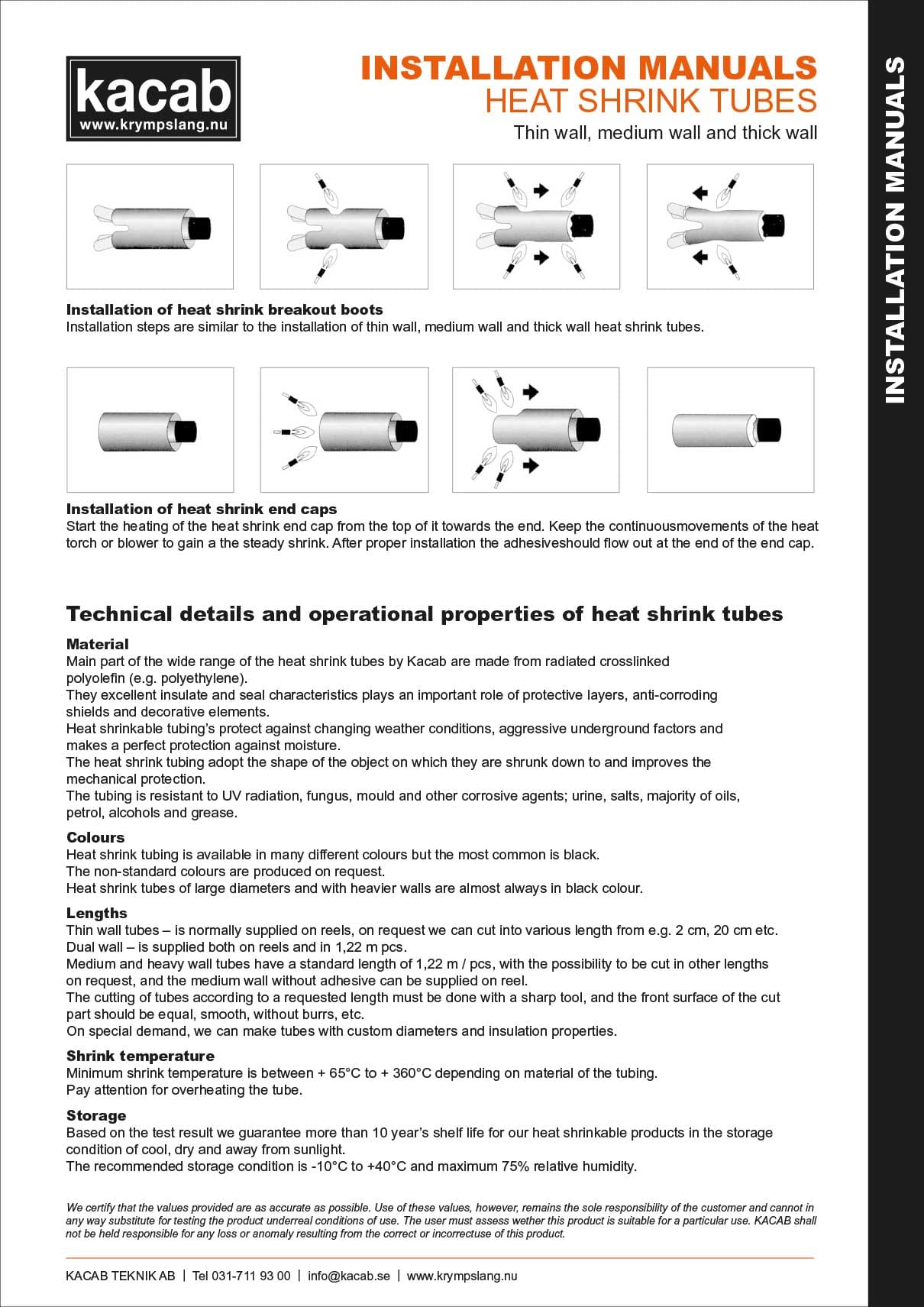Heat Shrink Tubing – Use of heat shrink tubing
Heat Shrink Tubing – Use of heat shrink tubing
Select the correct tubing
Initially, when using heat shrink tubing, keep in mind that the choice of heat shrink tubing affects the conditions of the application. The ambient temperature, the desired degree of shrinkage and whether the shrink tubing should be adhesive-coated or not are some issues that affect the choice of heat shrink tubing.
From this, we have now compiled the following questions that facilitate the selection of heat shrink tubing up to 1000V.
Good questions to ask to help you when using heat shrink tubing
Is it for general use or are there special requirements?
Special requirements can be, for example, high temperature, chemical resistance, other approval / certificate or labeling.
Should the shrink tube be With or without glue?
An adhesive-coated shrink tubing has a layer of hot melt adhesive on the inside that essentially fulfills two functions. To create a moisture barrier and a better grip between cable and shrink tubing. In short, we sometimes call our adhesive-coated shrink tubes dual wall.
What diameter and degree of shrinkage (shrinkability) do you need?
Choose the size so that shrinkage occurs by at least 20% and a maximum of 80%. The degree of shrinkage tells you how much the shrink tubing shrinks. Example of a degree of shrinkage 3: 1 with an unchrimped diameter of 45 mm shrinks down to 15 mm. Which means that some shrinkage takes place, in other words, also along the length.
So what wall thickness do we need?
There is a thin / medium / heavy-walled heat shrink tubing. The wall thickness of the shrink tubing is always defined at maximum shrinkage. This means that the heat shrink tubing is always thinner before installation. Our thin-walled shrink tube is more flexible and it can also be delivered on a roll which is faster to shrink. A thick-walled heat shrink tube therefore insulates better and therefore provides better mechanical protection against special abrasion.
Assortment of shrink tubing
I krympslangs sortimentet finns:
Tunnväggiga krympslangar, Mediumväggade krympslangar, Tjockväggade krympslangar, Enkel vägg, Dubbel vägg (dual wall), Krympslang i olika längder & på rulle, Flamhämmande krympslang, Krympslang med lim och krympslang utan lim, Krympslang tillverkad av polyolefin (POX), Elastomer (PES), Fluorpolymer (FPM), polyvinylidenfluorid (PVDF) och polytetrafluoretylen (PTFE) m.m.
The shrink tubing is available in different shrink ratios from 2:1 up to 6:1, however, for different applications.


Questions and answers
How to shrink heat shrink tubing?
You can find the best tips here:
1. Firstly, when heat shrink tubing is to be heated, it is recommended to start in center of the heat shrink tube, then gradually move towards one end and then from the middle again towards the other end. This way you can avoid air pockets in the shrik tube to clarify.
2. Next, heat shrink tubing throughout shrinks lengthwise as well. You should take this into account when cutting the heat shrink tubing.
3. If the object to be covered is made of metal or heat-conducting,it must be carefully ensured that the object is preheated to avoid “cold spots” or “cold marks”. It guarantees a snug and even fit of the tube.
4. When cutting the shrink tubing and cuffs to desired length, make sure the ends are smooth. Due to sloppy cut and uneven edges can cause heat shrink tubing and cuffs to crack during shrinking.
5. When choosing the size of the shrink tube, it is important to take into account the 80:20 rule at the same time. This means that the hose size must be chosen so that the shrinkage is at least 20% and at most 80%. Detailed examples of how to choose the right shrink tubing can be found in our catalog, in the section insulation products.
6. Finally, when shrinking, always ensure that the workplace is well ventilated and that you wear personal protective equipment such as gloves and goggles.
What are the most important parameters for the right choice of heat shrink tubing?
Heat shrink tubing wall thickness:
Initially, the thickness of the material is specified in millimeters after full shrinkage. “Nominal” defines the dimensions without any tolerances.
In general, you can choose between thin-walled, medium-walled and thick-walled heat shrink tubing. Heat shrink tubing is also available with adhesive. The industry also calls it double-walled heat shrink tubing.
Heat Shrink Tube Diameter:
However, for thin-walled heat shrink tubing with a shrinkage rate of 2:1 (standard heat shrink tubing) we usually specify the diameter in inch sizes, where 25.4 mm corresponds to 1 inch.
Shrinkage rate in connection with:
Depending on the material and wall thickness, our heat shrink tubing expands to different degrees.
A shrink ratio shows the speed and the shrinkage rate of the product (diameter in relation to the recovered diameter). The shrinkage ratio varies from 2:1 to 6:1. The higher the shrinkage ratio, the more variable the shrinkage diameter, thus fewer sizes of heat shrink tubing are needed, which helps to reduce bearings and requires less bearing space.
Change in length after shrinkage:
The shrink tubing not only has a smaller diameter, but even shorter length. We indicate the change in length after shrinkage as a percentage.
Minimum shrink temperature:
Not all heat shrink tubing shrinks at the same temperature. It largely depends on the type of material and also wall thickness.
In addition, what operating temperature:
The operating temperature varies with hose type. It certainly depends on which material was used for resp. tubing type. When choosing the right size, it is recommended to follow the 80:20 rule described above..
In conclusion, our heat shrink tubing is therefore widely used in wiring harness assembly. Heat shrink tubing can also be used for insulation, cable identification, mechanical protection and thus also for aesthetic design.
Good at Use of heat shrink tubing accordingly
To our new catalogue
How to shrink heat shrink tubing?
You can find the best tips here:
1. Firstly, when heat shrink tubing is to be heated, it is recommended to start in the middle of the tubing, then gradually move towards one end and then from the center again towards the other end. This way you can avoid air pockets in the shrik tube to clarify.
2. Next, heat shrink tubing throughout shrinks lengthwise as well. You should take this into account when cutting the heat shrink tubing.
3. If the object to be covered is made of metal or heat-conducting,it must be carefully ensured that the object is preheated to avoid “cold spots” or “cold marks”. It guarantees a snug and even fit of the tube.
4. When cutting the shrink tubing and cuffs to desired length, make sure the ends are smooth. Due to sloppy cut and uneven edges can cause heat shrink tubing and cuffs to crack during shrinking.
5. When choosing the size of the shrink tube, it is important to take into account the 80:20 rule at the same time. This means that the hose size must be chosen so that the shrinkage is at least 20% and at most 80%. Detailed examples of how to choose the right shrink tubing can be found in our catalog, in the section insulation products.
6.Finally, when shrinking, always ensure that the workplace is well ventilated and that you wear personal protective equipment such as gloves and goggles.
What are the most important parameters for the right choice of heat shrink tubing?
Heat shrink tubing wall thickness:
Initially, the thickness of the material is specified in millimeters after full shrinkage. “Nominal” defines the dimensions without any tolerances.
In general, you can choose between thin-walled, medium-walled and thick-walled heat shrink tubing. Heat shrink tubing is also available with adhesive. The industry also calls it double-walled heat shrink tubing.
Heat Shrink Tube Diameter:
However, for thin-walled heat shrink tubing with a shrinkage rate of 2:1 (standard heat shrink tubing) we usually specify the diameter in inch sizes, where 25.4 mm corresponds to 1 inch.
Shrinkage rate in connection with:
Depending on the material and wall thickness, our heat shrink tubing expands to different degrees.
A shrink ratio shows the speed and the shrinkage rate of the product (diameter in relation to the recovered diameter). The shrinkage ratio varies from 2:1 to 6:1. The higher the shrinkage ratio, the more variable the shrinkage diameter, thus fewer sizes of heat shrink tubing are needed, which helps to reduce bearings and requires less bearing space.
Change in length after shrinkage:
The shrink tubing not only has a smaller diameter, but even shorter length. We indicate the change in length after shrinkage as a percentage.
Minimum shrink temperature:
Not all heat shrink tubing shrinks at the same temperature. It largely depends on the type of material and also wall thickness.
In addition, what operating temperature:
The operating temperature varies with hose type. It certainly depends on which material was used for resp. tubing type. When choosing the right size, it is recommended to follow the 80:20 rule described above..
In conclusion, our heat shrink tubing is therefore widely used in wiring harness assembly. Heat shrink tubing can also be used for insulation, cable identification, mechanical protection and thus also for aesthetic design.
Good at Use of heat shrink tubing accordingly
To our new catalogue
Heat Shrink Tubing – The correct way – 6 good tips
Use of shrink tubing

Heat shrink tubing – that’s how you do it!


